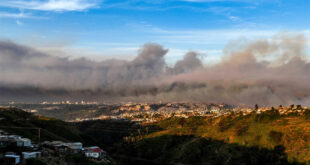Levels of particulate matter in Ho Chi Minh City have been falling in the past three years, according to a survey by the HCMC University of Science.
At a Monday conference on air pollution, To Thi Hien, subject head of Environment Technology at the university, said the survey revealed that PM2.5 levels in HCMC reduced from 25.9 microgram per cubic meter (μg/m3) in 2019 to 23.1 μg/m3 in 2020 and 22 μg/m3 in 2022. Peak levels of PM2.5 are usually recorded at 9 a.m., meaning people should refrain from going outside during the time frame, she said.
Particulate matter may contain inorganic substances like metal, organic substances like aromatic compounds and dioxides, and even living beings like viruses or molds. A worrying substance that has been detected among particulate matter in both Hanoi and HCMC are polycyclic aromatic hydrocarbons (PAHs), which are highly toxic.
“We found 15 metals among the PAHs, including mercury. Many substances that are potentially mutagenic and carcinogenic are found in high levels,” said Hien.
Air pollution mostly stems from artificial sources like industrial and domestic activities, including meat burning, smoking and fuel combustion. Pollutants may also react under different environmental conditions, producing even more dangerous substances, she added.
A major source of emissions stems from traffic activities, especially motorbikes, Hien said. As urban areas are expanded, people will spend more time on the street, increasing risks of exposure to pollutants. Policymakers and urban planners need to adopt strategic visions to alleviate this, she said.
“In the short term, Vietnam needs to quickly monitor motorbike emissions,” Hien said, adding that she supports measures to limit motorbike access in downtown areas and bolster public transport.
Gaelle Uzu, a researcher at the Institute for Environmental Geosciences of Universite Grenoble Alpes, said determining the components of pollutants is an important measure to evaluate their impacts on people’s health and the environment and to find their sources.
“Vietnam needs to have technical solutions to continually measure air quality on a large scale,” she said, adding that air pollution is the fourth leading cause of death globally.
About seven million deaths every year globally could be attributed to air pollution, with the figure around 60,000 in Vietnam, according to the World Health Organization. Hanoi and HCMC are among Asian cities with the worst air quality, it added.
- Reduce Hair Loss with PURA D’OR Gold Label Shampoo
- Castor Oil Has Made a “Huge” Difference With Hair and Brow Growth
- Excessive hair loss in men: Signs of illness that cannot be subjective
- Dịch Vụ SEO Website ở Los Angeles, CA: đưa trang web doanh nghiệp bạn lên top Google
- Nails Salon Sierra Madre
 VnExpress News The News Gateway of Vietnam
VnExpress News The News Gateway of Vietnam




